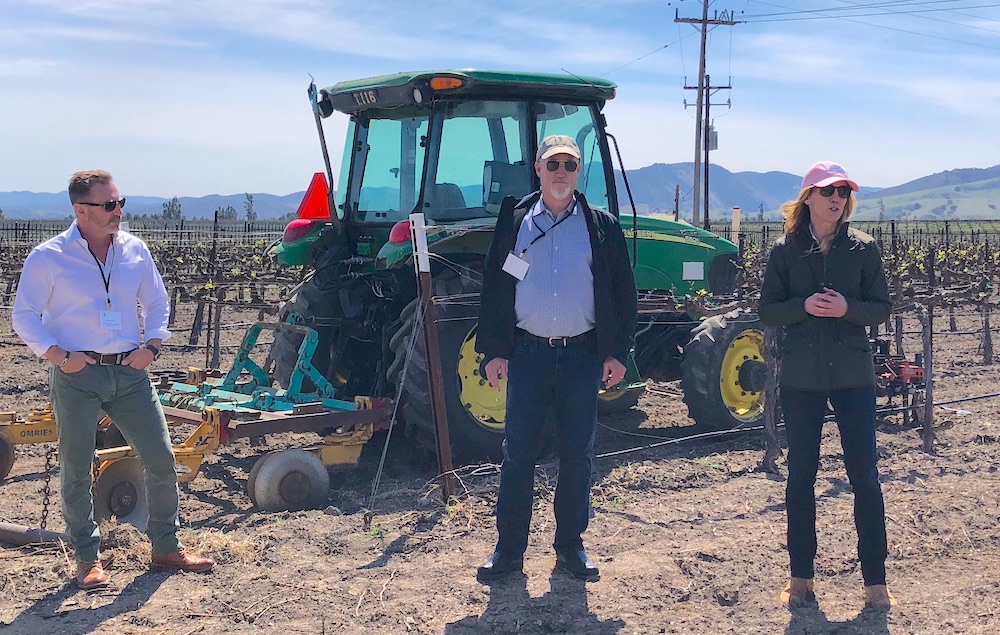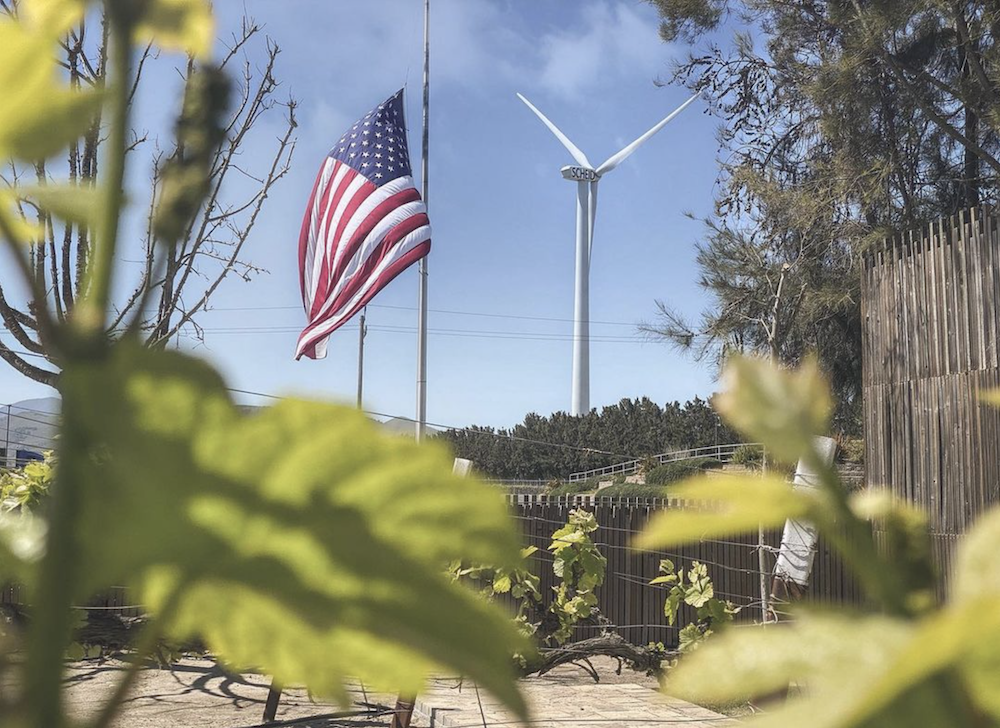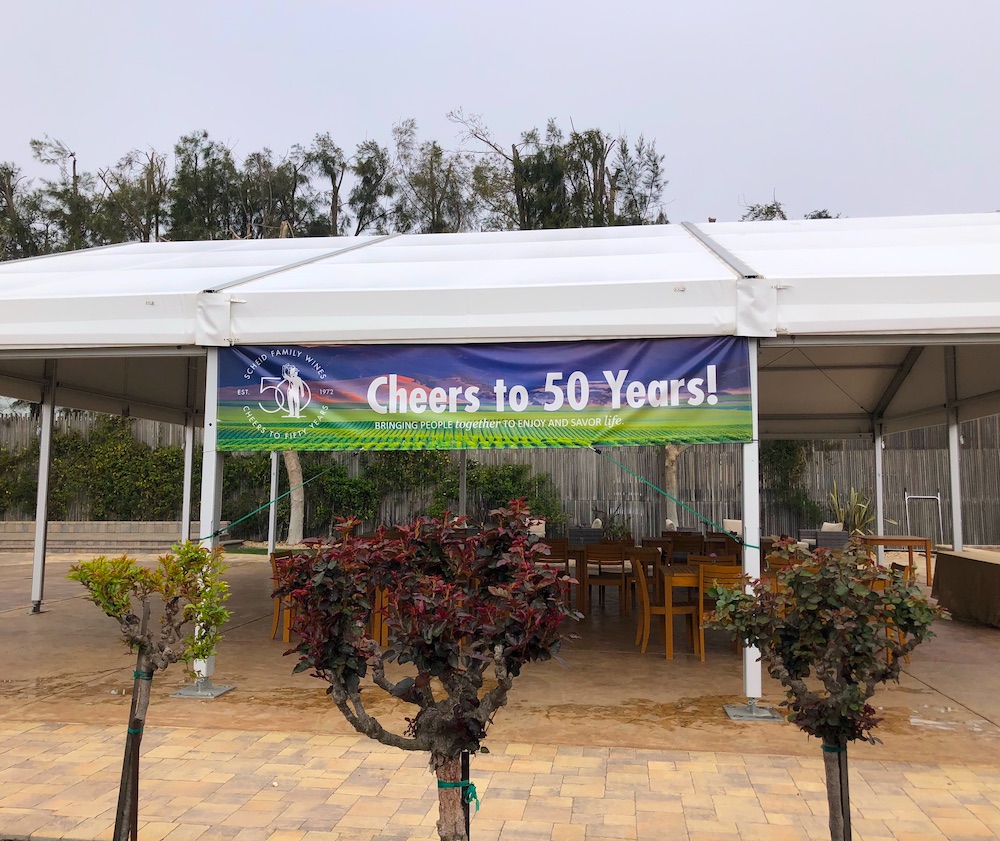
March 29, 2022 – A layer of fog brooded over the Santa Lucia Highlands bench like a fluffy grey hen as we traveled south on 101 towards Greenfield. We were on our way to a media gathering to celebrate 50 years of Scheid Family Winery. Fifty years!! 1972 was the year I graduated from high school. It was also the year that Al Scheid decided that grapes—vineyards, actually— were a great investment. It took me a while longer to figure that out. The quietude of the day soaked into every fiber as we traveled through the fields, spying vineyards just beginning to leaf out. The low flat light accentuated the bright green foliage, the silver fuzz of new growth sparkling like tiny diamonds.
We started looking for the landmark that would tell us we were getting close to Hobson Road, the site of Scheid’s original vineyard plantings. Just beneath the clouds it appeared: a huge white wind turbine, motionless in the morning stillness. The giant American flag hung listless, as if still lost in a dream of former glory. It used to be the hallmark of the Scheid tasting room and winery: for years, coming to Greenfield, we would look for the flag as the signal beacon.
But, since 2017, it has been this magnificent steel propeller in the sky that has towered above the property, proclaiming in very large letters that you have arrived at SCHEID.
Like most of us, the turbine works pretty hard when it has to: the rest of the time, it slumbers like a giant B-25 engine on pause.

By noon, not only had the flag stirred to life, flapping like a jib in a headwind, but the silver monster had begun slowly rotating its blades as the daily Salinas valley weather machine hit the Start button. It’s pretty much the diurnal cycle of what makes the Salinas Valley the Salad Bowl of the World, the Garden of Eating and the Grapefount of Winedrinking. As the sun begins to warm the earth, the cooler air from the ocean rushes in, bringing with it the lifting of the fog layer and the start of the invection process that at first feels warm, as the breezes intermingle. Around 1:30 to 2pm, though, that breeze turns decidedly maritime and the sting of it becomes noticeable. Jackets back on and good luck with the caps.
“That wind turbine is 400 feet tall,” explains president and CEO Scott Scheid. “Before we erected it, we had to allay concerns that it might interfere with the flight path of the condor. They live in the Pinnacles you passed on the way down here. They’re an endangered species, so there is no tolerance for the loss of even one. Zero.” He makes the point with his thumb and forefinger.
Fortunately, after some study, it was determined that the condors fly much higher than 400 feet, as they take advantage of thermals. In fact, these birds with wingspans of nearly 10 feet typically fly up to 15,000 feet. So the propeller project went ahead without fear of condors crashing into the blades.
“When the company we bought the turbine from, Foundation Wind Power, delivered the parts, they told us that installation would take place the next day,” says Scheid. “We wanted to put our name on it, and they said, ‘hurry up and get it done, because the two cranes we hire to put it up cost $40K per hour!’ It was now or never, so, we contacted Shawn and Anjanette Adams of Monterey Signs in Seaside and had them literally make the 9-foot high letters overnight. We were scrambling to put the letters on when the cranes pulled up!” It’s a good thing they had only six letters to worry about on each side.
The tower itself stands 264 feet above the ground, and each of the three blades is 132 feet long, making for the combined height of 396 feet.

Executive vice president Heidi Scheid is excited about the contributions of the wind turbine to the winery’s sustainability efforts, telling us, “This is a 1.85MW turbine. It generates enough electricity to power the entire winery operation, as well as 125 homes. We calculated that it produces enough clean energy to offset the carbon emissions of 350 cars per year. Think about taking that many cars off the road!”
The blades rotate at about 22 revolutions per minute when fully fired up, producing 7500 MWh and offsetting 3850 tons of carbon annually. The excess energy produced is not presently stored, although a battery storage system is definitely in the works. Scott Scheid says they are considering a Tesla battery wall. For now, they energy they don’t use goes back to the grid.
Asked why not solar, and Scheid has a quick answer. “We looked at solar, but here in this climate, there is too much daily moisture from the fog. And then there’s the wind. It literally blows all that agricultural dust down the valley and deposits it at this end. Guess where a lot of it ends up? Stuck to moisture on solar panels.” Instead of fighting the wind, they decided to harness it. And the turbine works anytime there is wind.
“During the summer, the wind starts after lunch and can blow all night! The wind turbine is a 24/7 operation and produces power whenever the wind blows. Unlike solar, it can make power at night!” he points out.
The wind turbine isn’t the only modern technology empowering Scheid towards better fruit and a more sustainable way of operation.
As we stood in the vineyard admiring that massive turbine, we turned our attention to Craig Winn, director of viticulture, who explained his philosophy of stewardship. “I take a targeted approach to every vine,” he explains. “Using [drones and] my smartphone, I can monitor where there are irrigation line leaks or damage from unwanted pests. This can literally be done on a vine by vine basis.” If he sees evidence of a mealy bug infestation, for example, he can dispatch a drone carrying a special wasp that will eradicate the pest. Drone technology enables him to target specific vines for application, rather than wholesale blanketing an entire row.
They use a mechanical weeder to dig out weeds under the vine, eschewing the use of chemicals. To support beneficial insects, they have insectary rows, interplanted around vineyard blocks, where the good bugs live, and from where they launch attacks on the bad bugs.
They use a system of sensors in the vineyard to monitor soil moisture levels, and carefully apply water only when and where it is needed.
“Anything I can do to produce better fruit makes the winemakers job that much easier. And it shows in the quality of the wine,” says Winn. “My job is to sustain these vineyards and keep them producing at an optimal level. Ultimately, that will keep this company sustainable for another 50 years. ”
While he’s only been there since September of 2021, he’s completely in synch with the Scheid vibe. It’s looking like a win-win with Winn, and wind.
About the author
Laura Ness is a longtime wine journalist, columnist and judge who contributes regularly to Edible Monterey Bay, Spirited, WineOh.Tv, Los Gatos Magazine and Wine Industry Network, and a variety of consumer publications. Her passion is telling stories about the intriguing characters who inhabit the fascinating world of wine and food.
- Laura Nesshttps://www.ediblemontereybay.com/author/lness/
- Laura Nesshttps://www.ediblemontereybay.com/author/lness/
- Laura Nesshttps://www.ediblemontereybay.com/author/lness/
- Laura Nesshttps://www.ediblemontereybay.com/author/lness/


